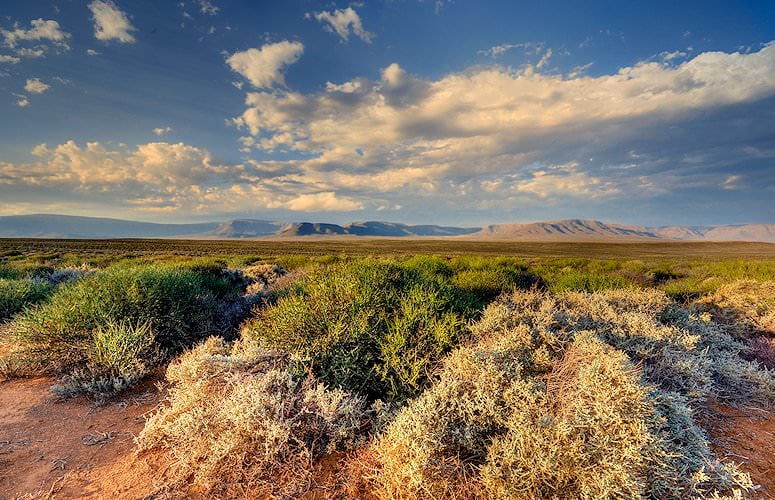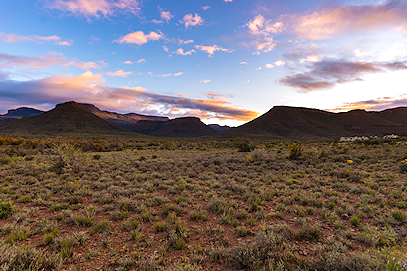The Karoo National Park was established on the outskirts of Beaufort West to conserve a representative sample of the region's unique natural heritage. It has been enlarged over the years and now encompasses vast, flat plains and the rugged Nuweveld Mountains. Though not one of South Africa's popular safari destinations, the park offers unique game-viewing opportunities.
Need Advice?The Karoo National Park offers some comfortable accommodation establishments in a unique area conservation area that is sure to appeal to avid nature lovers.

Animals such as mountain reedbuck, grey rhebok, kudu, steenbok, jackal, and aardwolf occur naturally. Reintroduced species include springbok, hartebeest, gemsbok (oryx), black wildebeest, Cape mountain zebra, and the endangered black rhino and riverine rabbit. Some 196 bird species have been recorded, and the park also sustains more than 20 black eagle pairs. Lions were reintroduced into the park in 2010 – the first lions in the Karoo in 170 years. Other predators include leopard, caracal, black-backed jackal, Cape fox, bat-eared fox, and several mongoose species.
The Fossil Trail is a must for all visitors to the Karoo National Park. It is even accessible to wheelchair users and makes for a great group outing. It is only 400m long, but it perfectly encompasses the geology and paleontology of the Great Karoo. It is an educational experience and can be done at your preferred pace.
The park has two picnic sites, which are perfect for taking some time out. Here you can enjoy the scenery while enjoying a meal or having a "braai" or barbecue. The Bulkraal picnic area has a large swimming pool that visitors can enjoy and is a great way to cool down after a long day in the Karoo heat.
The park offers various 4x4 eco-trails as well as self-drive opportunities. You can hop into the car and explore the roads whenever the need for adventure arises. The routes vary in difficulty degrees covering rocky ridges and sandy sections. Your African Sky guide will ensure you explore all the best roads.
Beyond its breathtaking solitude and silence, you'll find a wealth to savor in Karoo's seeming 'nothingness.' Take a closer look at the unique geology and learn about the region's prehistoric history.



The Karoo National Park is located just outside the town of Beaufort West. Guests traveling to the park will fly either to George International Airport in the Garden Route, located less than 300km from Beaufort West, or be chartered on a light aircraft to Beaufort West airstrip – depending on your safari itinerary.
The road from George to Beaufort West is one of the most beautiful in South Africa. Guests will be transported via a private, air-conditioned vehicle from George over the Outeniqua Mountains. The corridor connects the Little and Great Karoo with the western coastal regions and offers spectacular views of both.
The Karoo has a semi-arid climate, and extreme temperatures occur in summer and winter peaks. It is, therefore, best to visit in either spring or autumn when the temperatures are milder. In terms of wildlife viewing, however, it is a year-round destination. During the dry winter season from May to September, daytime temperatures are more comfortable than in summer.
Winter evenings can become quite cold, and morning game drives are chilly. When summer is in full swing in December and January, it gets boiling, sometimes uncomfortably, and daytime activities may be limited. Spring (September to mid-November) is a great time to visit, not only because of the milder temperatures but also because the flowers bloom during this time.
The Karoo National Park was officially proclaimed in 1979, and in 1989, the first rest camp was opened. It might have happened much later if it wasn't for the tireless efforts of a local farmer, William Quinton. Quinton was a born conservationist and enthusiastic birder. During the late 1950s, Quinton began campaigning for a conservation area close to Beaufort West, which led to the Town Council of Beaufort West donating 7 209 hectares of communal land to form the nucleus of the Karoo National Park. The South African Nature Foundation then purchased more land to be incorporated and created the Karoo National Park as we know it today.
The area takes you back hundreds of millions of years in history. The geological layer exposed to the surface is 0 "the Beaufort Group" – it was deposited between 240 and 280 million years ago. It reveals life in the area before Gondwana broke up 180 million years ago. Gondwana was a supercontinent consisting of what is today known as Africa, South America, Antarctica, India, and Australia. There is a fossil trail in Karoo National Park that guides you through the paleontology in the area. Ancient reptiles, extinct amphibians, and mammal-like reptiles are found on this trail. Paleontologists have painted a comprehensive picture of this prehistoric environment that can be easily understood.
The vast arid landscape of the Karoo National Park is host to an amazing array of animals. Dainty klipspringers can be seen all along the rocky outcrops. Herds of springbok, gemsbok, buffalo, Cape mountain zebra, red hartebeest, and eland fill the plains. If you are lucky enough, you might come across a browsing kudu. The cunning black-backed jackal thrives in this reserve, and bat-eared foxes come out at night when they mostly eat the local harvester termites. More than 20 breeding pairs of Verreaux's eagles nest here and can be seen gliding effortlessly as they scan the ground for unlucky rodents. They'll even pick off dassies (rock hyrax) from rocky outcrops.
Lions have been successfully reintroduced into the area and became somewhat famous when a young male named Sylvester escaped the park in 2015 and again in 2016. The highly endangered riverine rabbit has been successfully resettled. The reserve also contains Rau quagga. The Rau quagga resembles the extinct quagga that died out in the 1800s. The quagga was a subspecies of Burchell's zebra that looked just like the zebra, except that its back half was brown. The Rau quagga is just an artificially selected Burchell's zebra, bred to look like the quagga. The park has the most species of tortoise worldwide – five in total. The endangered black rhinoceros also occurs.
The Karoo is the largest ecosystem in South Africa. It comprises two biogeographical regions: the Namaqualand, Namib Desert and the Southern Karoo domain. Several vegetation types and unique geological features can be found in the Karoo, the world's only plant hotspot that is entirely arid. The area is also particularly well-known for its high levels of plant endemism, with more than 1 900 species that cannot be found anywhere else on earth. Despite its many unique trademarks, only 3% lies within areas focusing on conservation. The Karoo National Park conserves an area of approximately 760km².
The landscape is dry, harsh, and challenging. Nevertheless, a wide variety of fauna and an even wider variety of flora have adapted to survive these trying conditions. Deciduous dwarf shrubs and grasslands are the dominant vegetation types, including the Montane Karoo grassy shrublands, Karoo grassy dwarf shrublands, and Karoo succulent dwarf shrublands, to name a few. In terms of geological features, the park is situated in the Ecca Group of the Karoo Supergroup, which consists mainly of mudstone and sandstone that give the rocky outcrops and formations a striking red and gold tinge.
The Karoo is a vast land, and one of the best ways to explore its various attractions is by utilizing the four 4x4 eco-trails, such as the longer Nuweveld Eco Trail, which spans 90 km, and the short Afsaal Eco Trail, which is only 13km in extent. The Klipspringer Pass is a favorite amongst visitors, whereas the Pienaars Pass should be avoided unless you are interested in serious off-roading. Taking a walk through the 400m wheelchair-friendly Fossil Trail offers excellent insight into the ecology, physical structure, and paleontology of the Great Karoo. Actual fossils and fossilized trees can be seen. Experienced guides conduct drives and interpretive walks in the park.
Game drives are usually very successful – animals can be seen from miles away because of the sparse vegetation. The park also has two picnic spots. The Bulkraal picnic site is next to the swimming pool, where visitors can relax and enjoy the view of the landscape. It is also a great place to view the sunset and enjoy a sundowner. The Doornhoek site is within the game area and ideal for a bush picnic, lunch, and a well-deserved break after a morning drive. It is, however, not fenced, so it's best to stay within the designated area. Birding is a popular activity; birders can make their way to the specially constructed bird hide at the rest camp.